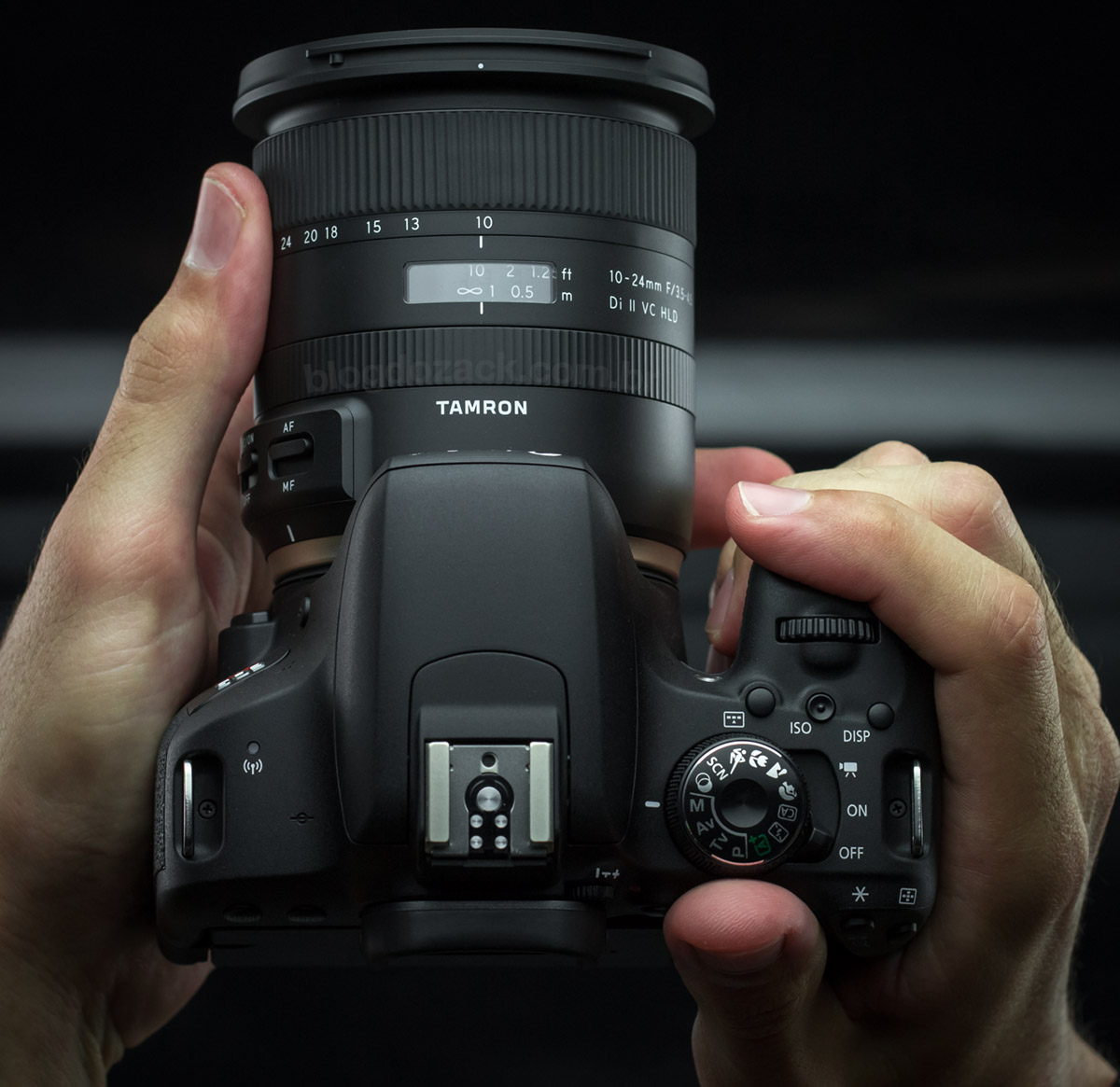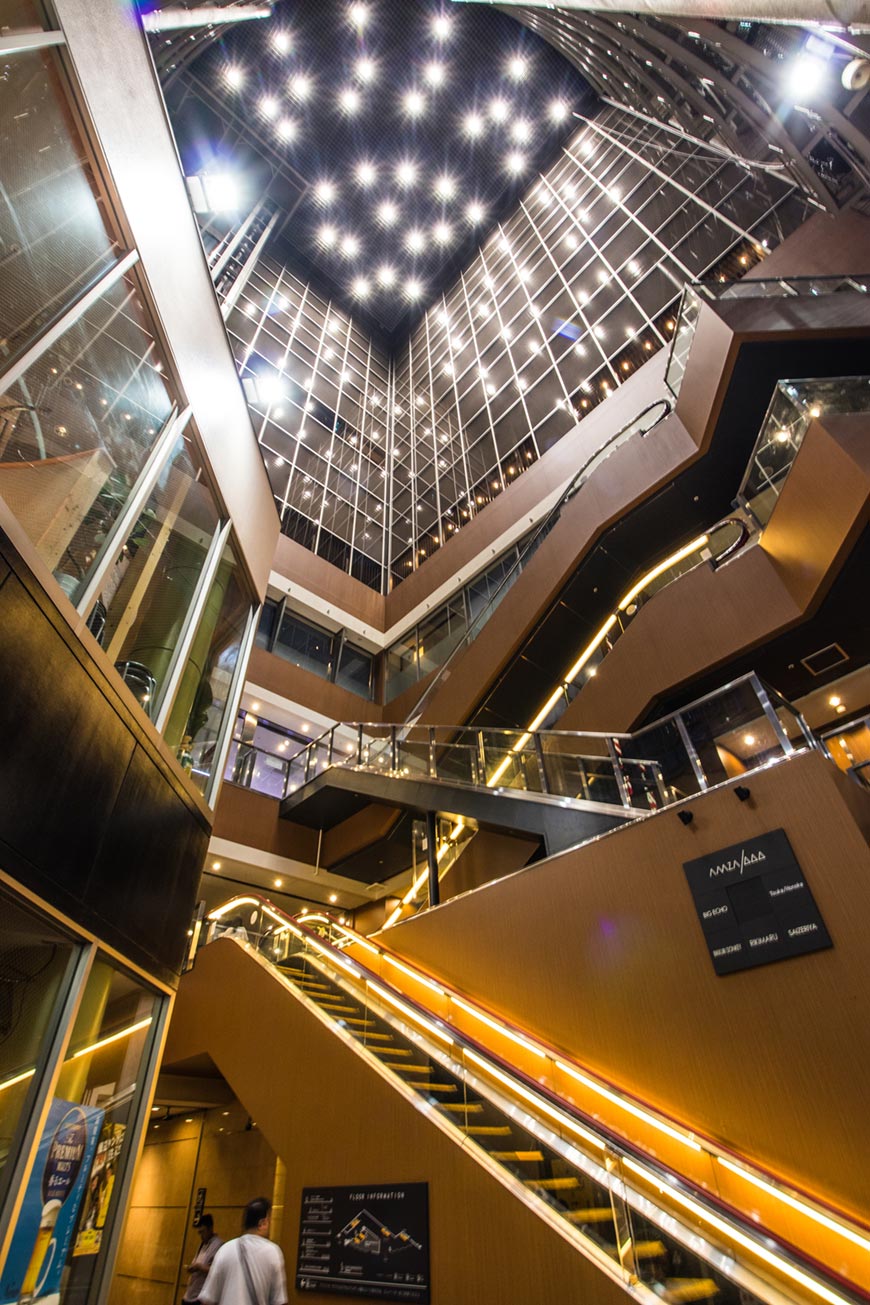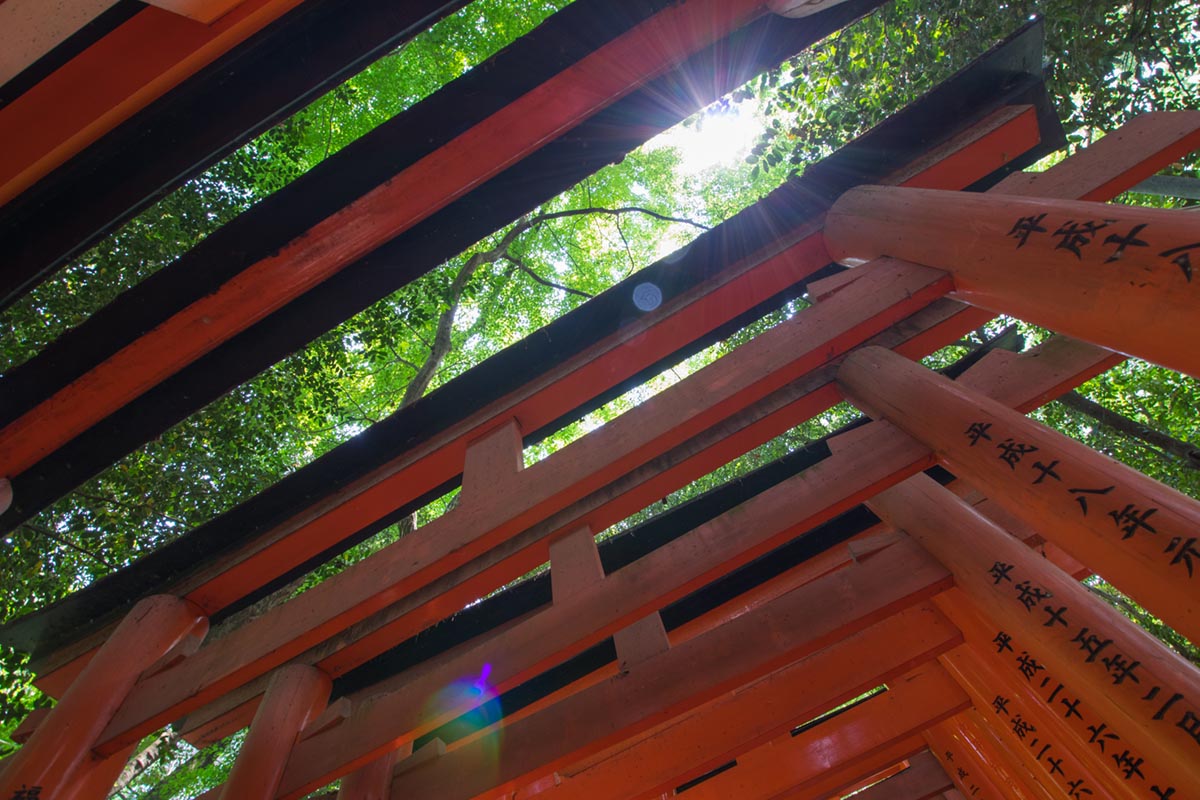Estimated reading time: 12 minutes.
August/2017 – The 10-24mm f/3.5-4.5 Di II VC HLD is the new stabilized-ultra-wide-angle zoom from Tamron. Following the steps of the recently revamped “SP” Super Performance lineup, that we first saw on the SP 45mm f/1.8 Di VC USD prime, the design, ergonomics, usability and quality controls were greatly enhanced for the new “premium low-cost” market, the same as Sigma’s Global Vision’s Art, Contemporary and Sports series; cheaper than first parties, but with excellent qualities. Gone are the golden embellishments and the weird usability from Tamron’s past, and we’re left with a sleeker design not offered by any first party on the APS-C market (maybe some mirrorless. Canon has the f/3.5-4.5 aperture on the jurassic EF-S 10-22mm USM (2004, US$649), but it lacks a built-in stabilizer; and the IS appears on the f/4.5-5.6 10-18mm IS STM (2014, US$279), with a smaller aperture. Nikon follows with its 10-24mm f/3.5-4.5G (US$899) or the newer 10-20mm f/4.5-5.6G VR (US$309), but Tamron adds both aperture and stabilizer for just US$499. Supporting Canon’s EF and Nikon’s F mounts, is it worth your kit? Let’s find out on this complete review. Nice reading.

At 8.4 x 8.2cm of 440g of mostly plastics, the 10-24mm II gets our attention due to its build: solid and precise; light and easy to use; a nice always-with-you lens. With a new design aesthetic called “Human Touch”, Tamron proposes a single width barrel finished with a satin plastic, wider at the front only to fit the large ø77mm vignette-free filters. It’s relatively large without being cumbersome, a mechanical-must for both the 10mm focal length; the maximum f/3.5 aperture; AND the built-in stabilizer. The plastic finishing is matte and smooth to the touch, almost rubberized, and a highlight for this price. Canon and Nikon both offer tougher plastics on its EF-S/AF lenses, and it impresses how Tamron managed to create the materials on the 10-24mm II.

In your hands the usability is fantastic for its well thought design and materials. At the front the zoom ring rotates from 10mm to 24mm in short 40º, and the internal barrel moves inside at 15mm; and outside at 10mm and 24mm (floating elements); not too tough to rotate, not too loose to be moved by accident. The rubberized ring is nice to the touch, with plenty of grip, and balances the camera at the rear. On the left hand side sits all the stabilizer and autofocus switches, again superior to Canon’s: big, smooth, with the same satin finish of the barrel, better than the older EF-S 10-22mm tiny bump. It’s easy to use even under low light, and serves as a reminder to first parties: it’s hard to swallow what they deliver on the APS-C market, and can I barely recommend EF-S/AF-S DX lenses. The APS-C format is better served by third party like Sigma, Tokina, and now Tamron.

At the rear sits the manual focusing ring that controls the all-internal 10-24mm II focusing group. This ring is thin and 100% plastic, not rubberized, and curious in operation: at the same time it is recessed in the lens body, nice not to be used by accident, it’s a pleasure to use, with precise movements. It’s the best of both words: if you’re planning on using the AF only, you won’t be bothered by the manual ring; but if you’re a fan of manually focusing, this piece is a pleasure to use. Better yet it supports the advanced “full time manual” operation, allowing for focus adjustments even when the AF mode is selected on the focus switch, faster to use. It’s much better than Canon’s STM EF-S 10-18mm, too lose and mechanically disconnected from the internal groups; or the awful One-Touch Clutch Focus from Tokina’s 11-20mm/11-16mm f/2.8 II AT-X PROs. So I applaud Tamron for it’s ergonomics, great even outside the more expensive Super Performance lineup.

Inside Tamron employs the new HLD focusing motor, different from the traditional USD motor we saw on both the SP 24-70mm f/2.8 and SP 45mm f/1.8. While the USD remind us of Canon’s USM, the HLD “High-Low Torque” is similar to Canon’s STM, smooth, precise and quiet; but not particularly fast (although not really slow). It’s always tricky to talk about autofocusing motors because many factors are in play for usability, precision and speed. But here tested with Canon’s EOS T7i, for example, practically every photograph from this review is in perfect focus, be it using the 45-point phase-detection module through the viewfinder; or using Canon’s fantastic Dual Pixel Live View. However the HLD is distinctively slower than Canon’s USM EF-S 10-22mm f/3.5-4.5, making it a hard recommendation for sport shooters. Canon locks focus almost instantly, whereas Tamron take’s near 0.5s to focus. But at least it all works internally and smoothly, and the HLD is welcomed by those shooting videos, made perfect with the various Dual Pixel focusing modes.

Also inside Tamron managed to fit its excellent VC “Vibration Compensation” module, rated at up to 4-stops; one of the best on the market in usage and power. Tamron actually is a leader in VC technology, always smooth and silent, but ever larger; paving the path for exotic lens specs like the newer wide aperture primes, or this wide aperture/wide angle zoom; thus the 10-22mm f/3.5-4.5 spec made possible, not offered by Canon nor Nikon. And it works as expected: it’s possible to capture near to 0.5 second exposures at 10mm, leaving the tripod at home. And during video recording the VC is mandatory for handheld shots, perfect for run-and-gun shooting. Just like we saw on the 45mm f/1.8 VC, the excellent stabilizer tech is Tamron’s strength on most kits: exotic specs, like wide angle and wide aperture. Sigma and Tokina could learn a thing from Tamron’s VC.

“Itsukushima Shrine” with the EOS T7i + Tamron 10-24mm f/3.5-4.5 Di II VC HLD at 1/5 f/7.1 ISO400 @ 10mm.

100% crop, the VC stabilizer easily “holds” the 10-24mm II for 1/5s.

Finally at the front the ø77mm filters are gigantic, but for a good reason: it eliminates any chance of vignetting. To optical elements are clearly smaller than ø77mm, so that’s the only explanation: to avoid vignetting. They fit inside the also gigantic included-in-the-box HB023 lens hood, and allows for polarizers and ND; useful in wide-angle photography. At the rear the metal mount is perfectly finished and protected by a rubber gasket, and Tamron declares further seals around the rings; despite recommending keeping the lens away from water. It also impresses the finishing on both lens caps (!), robust and heavy, smooth to use. The rear cap, for instance, have slits to make it glide over the lens mount. And the first glass element is fluorine coated, repealing water and grease for easy maintenance. It’s details like the solid and light build, the smooth finishing and the ease of use, together with the complete accessory kit, that brings the Tamron lenses closer to Sigma’s Art series. It’s a great low-cost alternative with no peers from first parties, and easy to recommend.

“Mall” with the Tamron 10-24mm f/3.5-4.5 Di II VC HLD at f/5.6 1/8 ISO100 @ 10mm. All photos with the Canon EOS T7i; raw files available at Patreon.
With an impressive 16 elements in 11 groups formula, one XLD piece (Extra Low Dispersion), one LD (Low Dispersion), aspherical glasses and hybrid-aspherical, paired with the advanced BBAR coating, the Tamron 10-24mm f/3.5-4.5 bring to the APS-C format a 16-38.4mm full-frame 135 equivalency; an ultra-wide-angle made to play with the frame lines. A near-mandatory spec on every kit, it will be wider than most zooms, allowing for far more elements to fit in the same frame; a challenge to your creativity and composition, and also to the technical formula. But optically the Tamron 10-24II delivers: considering this generation’s high resolution APS-C cameras, it’s impressive what the lens delivers on details wide-open; minimal lateral chromatic aberrations; easy to fix geometry; and good flaring resistance. Tamron is yet another example of a modern lens.

“Miraikan” with the Tamron 10-24mm f/3.5-4.5 Di II VC HLD at f/6.3 1/8 ISO100 @ 10mm.
Wide open it’s easy to notice this generation’s APC-S resolving power, and Tamron optical wide-angle expertise; as long as we don’t inspect the frame edges. The issue is not even optical, but physical. Given the short depth of field at f/3.5, most tridimensional subjects won’t fit the image plane, rendering compositions with strong vantage points near useless; given the lack of overall sharpness. It is difficult to complain about the f/3.5 performance because either your subject won’t fit the image plane, or the problem lays in your weak composition. What’s interesting is the well controlled vignetting, with minimum luminance lost, an issue from even the smaller aperture f/4.5-5.6 zooms from first parties. It’s a good performance for indoor photographs, using the larger aperture to lower the ISO, thus enhancing image quality. The 10-24mm II design is well planed, and delivers the declared spec. But it is up for the photographer to really push its best: for great wide angle shots, it’s almost mandatory to stop down the aperture in order to get a longer depth of field.

100% crop, sharp image frame when wide-open, great to speed up the shutter speed.

100% crop, sharp center frame, perfect for low light shots.

100% crop, as long as your motif fits the image plane, it will be sharp even when wide open.

100% crop, hard to get sharpness from such a shallow depth of field.
Stopping down exponentially enhances the corner resolution, recommended for those shots meant to be printed. On this generation’s APS-C 24MP 6000×4000 files, great sharpness can be delivered even from the simplest kit, non full-frame, useful for landscape, product, interior design and street photographers to make due 1) without the limitations of a prime wide-angle lens or 2) the investment on much more expensive lenses and cameras. While I’d never used the US$899 AF-S 10-24mm f/3.5-4.5G, we can’t forget the lackluster performance from the EF 10-22mm USM: no edge details, even stopped down; a disaster 13 years ago. So this Tamron alternative becomes almost the only option for today’s Canon shooters, that can’t work with the limited 10-18mm aperture. So Tamron supports both markets: wide aperture and stabilized, all in a super-wide-angle zoom.

“Kiyomizu-dera” with the Tamron 10-24mm f/3.5-4.5 Di II VC HLD at f/6.3 1/50 ISO100 @ 15mm.

100% crop, plenty of resolution from this Tamron and the APS-C format.

“Tokyo-to” with the Tamron 10-24mm f/3.5-4.5 Di II VC HLD at f/7.1 1/320 ISO100 @ 10mm.

100% crop, great overall resolution despite some lateral chromatic aberration.

100% crop, sharp lines around the frame, with greater depth of field.

100% crop, acceptable resolution for the format and price point.

100% crop, stopping down is great to render more details in the images.

100% crop, even at the longer focal length, the zoom design maintains a good detail rendering for street photography.

100% crop, great raw resolution from a low-pass enabled EOS T7i APS-C sensor.
Chromatic aberrations are visible on the 10-24mm II images, the norm on the ultra-wide-angle zoom market; although as discreet as possible. While some brands opt for a mandatory electronic software profile to correct it’s wider lenses, Tamron makes due with optically enhancing the formula itself; one of the best ever tested. Coming from Tokina’s 11-22mm f/2.8 AT-X PRO, Canon’s EF 16-35mm f/4L IS USM, and why not include the EF-S 18-135mm f/3.5-5.6 IS USM, all more expensive than this Tamron, the 10-24II certainly surpasses CA better than its peers. It’s specially useful during video capture on cameras that can’t fix aberrations on-the-fly (Blackmagic, RED cameras, EOS C) and, don’t forget, the Tamron features the built-in VC for great handheld shots. So it’s yet another great example of the good formula using low-dispersion and aspherical glasses.

100% crop, discreet lateral chromatic aberrations from the Tamron 10-24mm II.

100% crop, minimum chromatic aberrations even on the widest angle.

100% crop, worst case scenario for the chromatic aberrations, given the extreme contrast subject.

100% crop, 21mm focal length practically free of chromatic aberrations.
“Miraikan II” with the Tamron 10-24mm f/3.5-4.5 Di II VC HLD at f/6.3 1/8 ISO100 @ 10mm; before and after the electronic software compensation. “UP” with the Tamron 10-24mm f/3.5-4.5 Di II VC HLD at f/7.1 1/30 ISO200 @ 10mm; before and after the electronic software compensation. “Asakusa” with the Tamron 10-24mm f/3.5-4.5 Di II VC HLD at f/3.5 1/30 ISO1000 @ 10mm; before and after the electronic software compensation. “Itsukushima Shrine II” with the Tamron 10-24mm f/3.5-4.5 Di II VC HLD at f/7.1 1/10 ISO400 @ 10mm; before and after the electronic software compensation.Geometric distortions are also visible on the wide-angle end at 10mm, and must be fixed via software; maybe the solely issue from the 10-24II. Despite the physically long optical formula (8.4cm) and the long flange distance of the EF/F-mounts, Tamron do show a visible bulge on geometric compositions, specially on horizontal lines near the edges; noticeable on architectural shots. While it’s far from a fisheye distortion, and its performance is much better than Canon’s EF-M 11-22mm f/4-5.6 IS STM – a great example of the difficulties from the mirrorless market – other modern lenses from the larger full-frame market are better at rendering straight lines. But it’s the price we pay from the size and practicality of the APS-C format at US$499.
Finally the colors are interesting on the 10-24mm II files, thanks to Tamron’s BBAR coating. The BBAR (Broad-Band Anti Reflection) is nothing more than a chemical layer applied on the lens glasses, an effort to: enhance light transmission, keeping the images sharp; enhance contrast, for faithful colors; and avoid internal reflections, that reduces both qualities. The 10-24mm colors are nearly identical to Canon’s ultra-wide-angles, great for landscape and culture photographers, with a vivid spectrum reaching the digital sensor. The internal reflections are also practically invisible on everyday shots, showcasing the BBAR tech, by far one of the clearest photo albums at this price point. With the exception of just two photos that I included the sun within the frame, no other shot rendered flaring or ghostings, great to shoot Japan’s overly illuminated streets. It’s the same performance you get from larger lenses, but here portable on the APS-C format.

“Osaka” with the Tamron 10-24mm f/3.5-4.5 Di II VC HLD at f/5.6 1/6 ISO200 @ 10mm; slight signs of flaring.

“Fushimi Inari” with the Tamron 10-24mm f/3.5-4.5 Di II VC HLD at f/6.3 1/10 ISO200 @ 10mm; flaring generated by the sun in the frame.

“Fushimi Inari II” with the Tamron 10-24mm f/3.5-4.5 Di II VC HLD at f/5.6 1/10 ISO100 @ 10mm; bad sun positioning in frame can disrupt the overall file contrast.
The Tamron 10-24mm f/3.5-4.5 Di II VC HLD is a good example of what the technology from a third-party manufacturer can bring to the photographic market; with a well made design, high quality ergonomics and great performance despite the lower cost. Not only it manages to match the f/3.5-4.5 to the built-in stabilizer, not delivered by Canon nor Nikon, the new Human Touch design impresses for it’s precision, following the steps of Sigma’s Global Vision. While Canon and Nikon diminishes the APS-C market to entry level cameras (except the 7DII and the D500), offering expensive lenses that lacks features, the third-parties takes the low-level photographers seriously with better products; no matter the price. And that’s how the 10-24mm works: be it for those suffering with the EF-S 10-22mm USM performance, or the f/4.5-5.6 from the 10-18mm STM, the Tamron is the perfect alternative. So for every photographer, this is the best choice. Nice shooting!